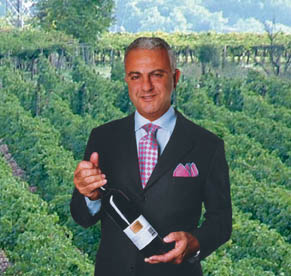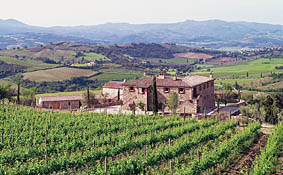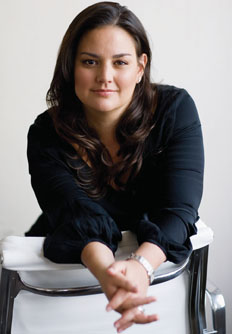
21st-Century Wine Seller
by Jenny Owen
 At the 2007 Global Alumni Conference in Florence, alumnus Leonardo
LoCascio participated in a panel discussion on Italian wines.
STERNbusiness spoke with this wine connoisseur and distributor.
At the 2007 Global Alumni Conference in Florence, alumnus Leonardo
LoCascio participated in a panel discussion on Italian wines.
STERNbusiness spoke with this wine connoisseur and distributor.
Known
for putting Italian wines on the American map, Leonardo LoCascio
(BS ’71) is also considered one of the “visionaries
in America who are not only changing the way we think about wine
but also determining what we’ll be drinking in the 21st
century,” as Food and Wine noted when it awarded the native
of Palermo, Italy, its highly coveted Golden Grape Award in 1998.
The president and CEO of Winebow, Inc., a leading importer of
premium Italian wines and a major distributor of wines from around
the world, LoCascio has made it his business to select high quality
wines of good value.
His Winebow portfolio represents more
than 70 estates throughout the major wine regions of Italy
and contains 3,000-plus wines from around the world. But the
Leonardo LoCascio Selections logo most reflects his personal
taste and appears only on his prized Italian imports. For every
wine he selects for this collection, he turns down dozens. “Wine for me is more than just a
beverage in the bottle,” explained the former banker. When
selecting wines, he looks for those that “make a statement,
that get people’s attention, that aren’t like a lot
of other wines. I’m looking for the purity of flavors,
for winemakers who don’t filter out the taste,” he
said.
“We have a big portfolio of wines from lesser known producers
and from outside the traditional appellations,” LoCascio
added. “So the idea of having my name on every bottle of
wine is to give consumers a roadmap or a common thread through
Leonardo LoCascio Selections. If they had a good experience with
one of my wines, they are more inclined to try another.”
Working with family wineries and searching
for unique, affordable wines is another key component of his
strategy. “I like
to find wines that over-deliver in terms of the relationship
between price and quality. We’ve often found these by going
to the more obscure regions of Italy,” said LoCascio. “And
it’s important to have in my portfolio wines that come
from families as opposed to large conglomerates. I find it important
to get to know the people you’re doing business with.”
In 1980, LoCascio left a successful career
in corporate finance to launch Winebow. At the time, he was
a vice president at Citibank, after having worked at Rockwell
Financial and McKinsey & Company.
His intentions were always to own and run a company. Entrepreneurship
is in his DNA – his father and his grandfather owned a
citrus business. LoCascio said he initially came to the States
and to NYU intending to get a degree and then to go back and
take over the family business. “But when I was here, I
got interested in living in the States, and in gaining some work
experience here,” he said. By the time he was ready to
flex his entrepreneurial muscle, his father had sold the family
company and LoCascio had become interested in imported foods
and beverages.
LoCascio was attracted to wine because
of its “simplicity
and sophistication.” He also saw a business opportunity. “Americans
were on the cusp of making wine a part of their lifestyle. At
the time, they were drinking a lot of beer and hard liquor. California
wines were hardly on the map,” he said. “But wine
was part of life in most Western countries. Americans, when they
went to Europe, enjoyed it and I could not understand why it
was not part of the lifestyle when they came back. My bet was
that it was going to become part of the American lifestyle.”
LoCascio bet correctly. As an Italian,
he was uniquely positioned to build a business around Americans’ demand for Italian
goods. “Americans have had a love story with Italy. Things
made in Italy were well-received here – fashion, design,
food,” he said.
Winebow wasn’t an instant success. LoCascio said it took
10 years before the business looked like it was going to succeed
financially. “Despite my academic and professional training,
I started my business as many entrepreneurs do, without adequately
capitalizing it,” he said. “In the initial years,
the biggest struggle was convincing the banks that it was worthwhile
to finance the growth of my business.”

San Polo, LoCascio's Tuscan winery in Montalcino, Italy. |
So his advice for aspiring
entrepreneurs is to “work not
only on the concept of what you want to do, but also on having
funds. It takes patience and discipline to capitalize the business
properly.” He also advises, “Have tenacity. Stay
focused on what you’re building – you really have
to believe that it will work out. In my case, I had two young
children and two mortgages, so failure was not an option.”
Winebow’s success today is due not only to LoCascio’s
tenacity and his prudent wine selection process, but also to
his business model. In the US, the wine business is regulated
by the states, and laws do not allow restaurants, retailers,
or consumers to buy wine directly from suppliers – they
must buy from local distributors. These regulations have generated
a three-tier business: the point of contact with the consumer
(retailer or restaurant), the local distributor, and the supplier
(winery or importer). LoCascio’s model has been to “try,
within the regulations in which we operate, to shorten this chain
and to be both an importer and a distributor within six markets:
New York, New Jersey, Connecticut, Massachusetts, Pennsylvania,
and Washington, DC,” he explained. “This has given
us extra margins, and most important, the ability to execute
on our own products, as opposed to having to convince a local
distributor to buy our wines over another importer’s.”
New York City is Winebow’s largest market. “It’s
a sophisticated city – there are a lot of people who love
wine and want to learn more,” LoCascio explained. “There
is also a strong international community with tourists and expatriates – which
all make for a great place to do business. And new restaurants
open every day, which become new customers.”
What can America expect next from this
wine visionary? Three years ago,Winebow partnered with Freeman
Spogli, a privaty equity firm that specializes in the distribution
business. Together the two are negotiating the purchase of
distributors in additional markets. “We want to be in as many markets as it makes
economic sense,” LoCascio said. The company is also expanding
its import footprint. It branched beyond Italy and into Spain
and South America a few years ago, and is currently looking at
Portugal. “We are always interested in expanding our horizons,” he
said. But will Americans be as receptive to expanding their own
wine palates? If Food and Wine magazine is right, it’s
Leonardo LoCascio who determines what we’ll be drinking
in the 21st century.
Passion for Fashion
by Rika Nazem

Chaiken's fall 2007 clothing line. Photo
credit: Don Lecca for Chaiken. |
It can take decades for a fashion company
to build brands that are described as sophisticated and classic.
But Julie Chaiken (MBA ’93), who founded Chaiken Clothing in July
1994, has needed only a single decade. With clients such as
Gwyneth Paltrow and Cameron Diaz, it’s easy to see why
this fashion line has continued to gain momentum in an industry
with a clientele that can be tough to please. Just take a look
at the fall collection and you’ll see beautiful, affordable
clothes for both work and play that women love to wear. Chaiken
views herself as a client of her own line and, as such, designs
clothes that fit her lifestyle.
Chaiken has always had a passion for
fashion. “In the
early 1990s, I remember talking with a group of friends about
fashion and what was available at the time,” she explained. “The
clothing choices for professional women were remnants of the
1980s when women were wearing bad blue suits. My friend and
I decided to do something about it. I always wanted to run
my own business someday and it just seemed like the right fit.” Chaiken
wanted to design versatile clothes for the professional woman
and jumped into the business by asking questions. “I
needed to obtain a business license, find a factory to manufacture
the clothes, and negotiate with the factory,” she said. “There
was a huge learning curve, but I had tenacity and just kept
asking questions until I figured it out.”
In the beginning, Chaiken thought that
she could do it all – design
and make the clothes, attend trade shows, and work directly
with customers as her own sales representative. “After
two weeks, I realized that was a very bad idea – especially
since, in those two weeks, I picked up the Barney’s New
York and Fred Segal accounts,” she said. “I knew
I was onto something but, at the time, didn’t understand
the scope of what we were starting. I wrote a business plan
and within a month it didn’t mean anything.” Chaiken
then hired a person to manage the factory and a sales team
to interact with customers. “Within the first six months,
we went from start-up to management mode, which we had talked
about in business school as being a very tough transition to
make.”

Julie Chaiken |
Chaiken’s business acumen got her through the tough launch
and transition phases. “Having an MBA in this industry
definitely gives me credibility. I have been able to step back
and take a breath, and evaluate situations I may have looked
at differently otherwise,” she said. “And the Stern
credential is invaluable when I meet with bankers. They so
often deal with creative types that have great ideas but not
the business background. For instance, I can look at a licensing
deal, and see the numbers and the business value in it. It’s
given me a much broader perspective on the business.”
Success in the fashion business also
requires “a lot
of being in the right place at the right time, and a lot of
offering the customer something she wants,” added Chaiken. “You
have to be out there. I still go to trade shows and meet with
clients. Coming back from a recent trip, I remember talking
to an investment banker on the plane. I asked him what he was
doing and he replied that he came to shake a hand. It’s
so true – we can’t forget that intangible of a
face-to-face meeting,” she said.
Building on her brand’s success, Chaiken has expanded
her well-known collection to include maternity wear, including
a new mommy bag just out in stores, as well as an eyewear line
that is due out next year. Her recently launched line, “Profile,” is “a
very fashion-forward line that will continue to push boundaries.
The line caters to women who are interested in fashion but
not necessarily interested in the trend of the moment,” she
said.
Despite spending the majority of her
time in San Francisco, Chaiken draws a great deal of her
inspiration from New York City. “Watching the people in the City is inspiring because
there is so much individuality. People mix things differently.
I love to go to the night clubs and look at what the kids are
wearing,” explained Chaiken. Museums and art exhibits
also inspire her. “I’ll see an exhibit and, 12
months later, you will see some element of that in the stores.
I saw a fabric exhibit at the Neue Galerie and, a year later,
I saw those prints coming into the market. Sometimes it’s
even just looking in the stores and seeing what other designers
are doing that gets the juices flowing,” she said.
Chaiken, who is the mother of two young
children, has found a way to handle both roles. “I don’t work a full
schedule anymore – I scaled back so that I have time
to be a CEO and a mother,” she explained. She notes that
a quote – “Nobody ever told me I couldn’t
have it all, they just forgot to tell me I couldn’t have
it all at once” – really resonates with her “because
I could do it all but I couldn’t do it all well. If I
want to do well in my business and I want to be a good mother,
I have to find time to do both,” Chaiken added. “I
really do love the life that I’ve built. It’s that
simple.”


![]()